Latest news about Bitcoin and all cryptocurrencies. Your daily crypto news habit.
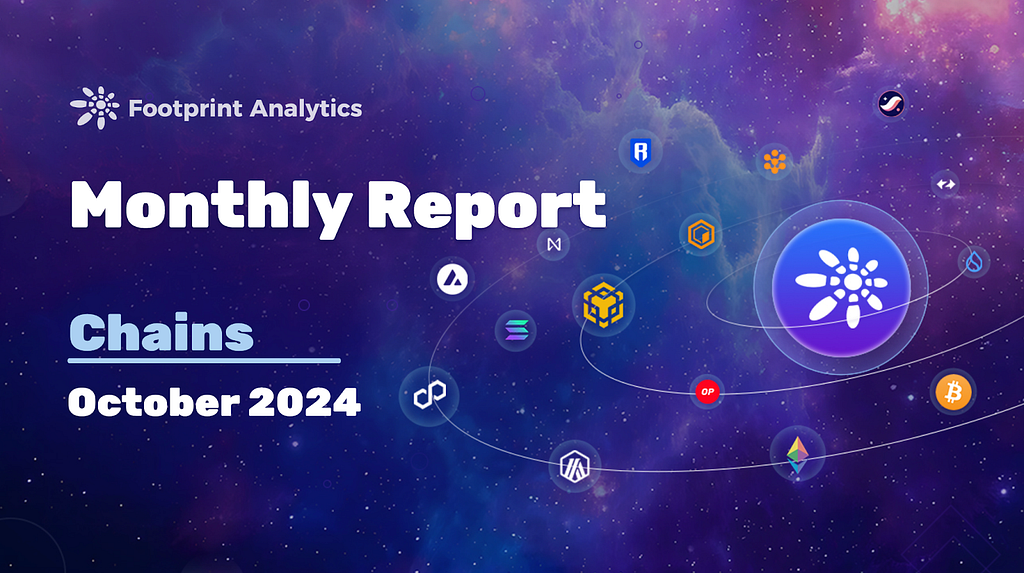
Author: Stella L (stella@footprint.network)
Data Source: Footprint Analytics Chains Research Page
Exactly 16 years after Satoshi Nakamoto published the Bitcoin whitepaper on October 31, 2008, Bitcoin once again demonstrated its revolutionary impact on the financial world. October 2024 saw Bitcoin approach its all-time high amid strong institutional adoption, while the broader blockchain ecosystem continued its rapid evolution. The month highlighted stark market divergence, with Bitcoin’s 15.9% surge overshadowing Ether’s modest gains, as Layer 2 solutions across both networks matured and expanded. Meanwhile, emerging chains like Sui gained momentum through innovative approaches to user acquisition and ecosystem development.
Data for this report was obtained from Footprint Analytics’ Chains Research Page, an easy-to-use dashboard containing the most vital stats and metrics to understand the public chain industry, updated in real-time.
Monthly Market Overview
October 2024 marked a period of notable market divergence, with Bitcoin leading the advance while other cryptocurrencies showed more restrained gains. Bitcoin demonstrated exceptional strength, climbing 15.9% from $60,764 to $70,398, touching $72,751 on October 29, near its March all-time high. Meanwhile, Ether charted a more modest trajectory, gaining 2.7% to close at $2,519.
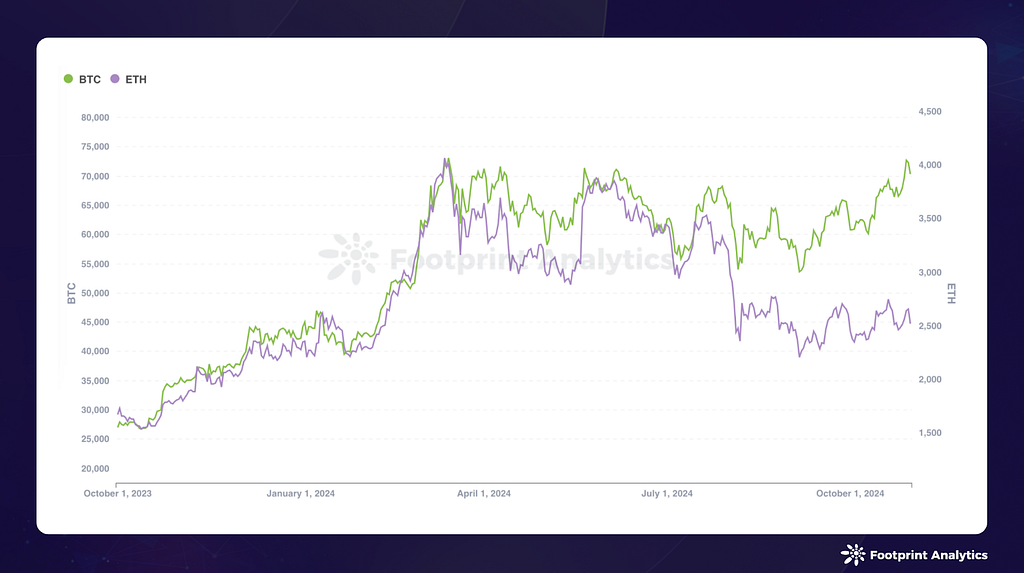
Source: BTC Price & ETH Price
Several macroeconomic factors shaped market dynamics during the month. Global currency movements, particularly the strengthening U.S. Dollar against major currencies including the Chinese Yuan, influenced crypto market flows. This shift occurred against a backdrop of rising bond yields and increasing gold prices, reflecting evolving risk perceptions in global markets.
Political considerations increasingly shaped market sentiment as the approaching U.S. elections emerged as a significant market driver. Bitcoin’s gains accelerated as investors positioned themselves ahead of potential policy shifts, with markets carefully weighing the implications of different electoral outcomes for digital asset regulation and broader financial policy.
Institutional engagement remained a key market driver, evidenced by substantial inflows into Bitcoin exchange-traded products (ETPs). This trend highlighted growing institutional comfort with digital assets as a strategic investment vehicle, even as selectivity in positioning became more pronounced.
Regulatory developments continued to impact the market landscape. A landmark FBI investigation involving the creation of NexFundAI token led to charges against three cryptocurrency companies and 15 individuals for market manipulation. Meanwhile, Crypto.com’s legal challenge against the SEC highlighted ongoing tensions between industry players and regulators, particularly regarding the “regulation by enforcement” approach.
Layer 1
October 2024 saw blockchain cryptocurrencies’ total market cap rise 6.7% to $2.0 trillion, with Bitcoin strengthening its market dominance to 70.1%, up from September’s 67.3%. Meanwhile, Ethereum’s share continued its decline, dropping from 16.8% to 15.3%, while BNB Chain and Solana maintained relatively stable positions at 4.2% and 4.0% respectively.
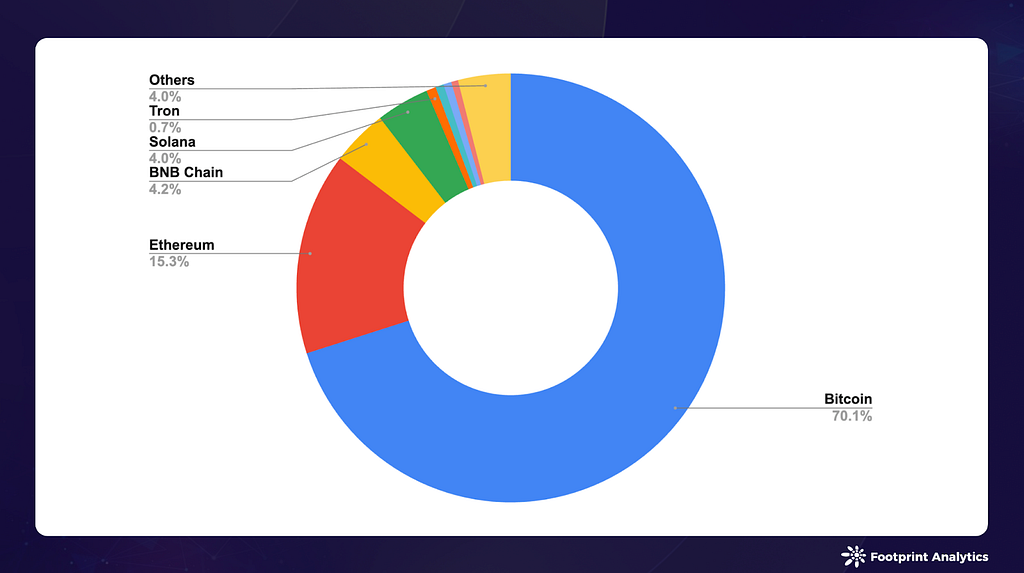
Source: Chain Token Market Cap Share
The market’s growth was primarily driven by strong performances from established tokens, with Bitcoin leading the charge alongside notable gains from BitcoinCash (12.9%) and Litecoin (9.5%). Solana maintained its position as one of the strongest performing altcoins with a 17.6% increase, while emerging blockchain Sui continued its upward trajectory with an 11.5% gain.
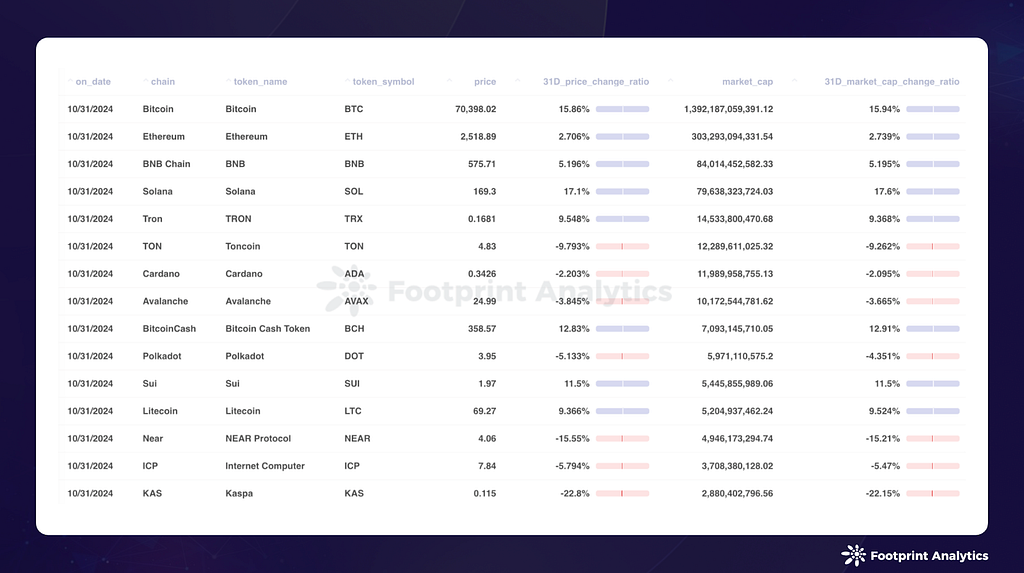
Source: Chain Token Market Cap and Price
Sui’s ascent to 11th place in market cap rankings. Leveraging opportunities in memecoin trends and Telegram-based gaming, Sui significantly expanded its DeFi ecosystem. The launch of Circle’s native USDC on Sui in October marked another milestone in its development. However, this growth wasn’t without controversy — allegations of “$400M in token sales by Sui insiders” emerged, and while denied by the Sui Foundation, sparked community debate.
The DeFi sector faced headwinds in October, with total TVL decreasing 6.8% to $63.5 billion. While the Bitcoin ecosystem showed strength, Ethereum’s DeFi landscape underperformed. A notable exception was Polygon, which saw a 30.3% TVL increase, primarily driven by Polymarket’s record-breaking performance as U.S. Presidential election speculation intensified.
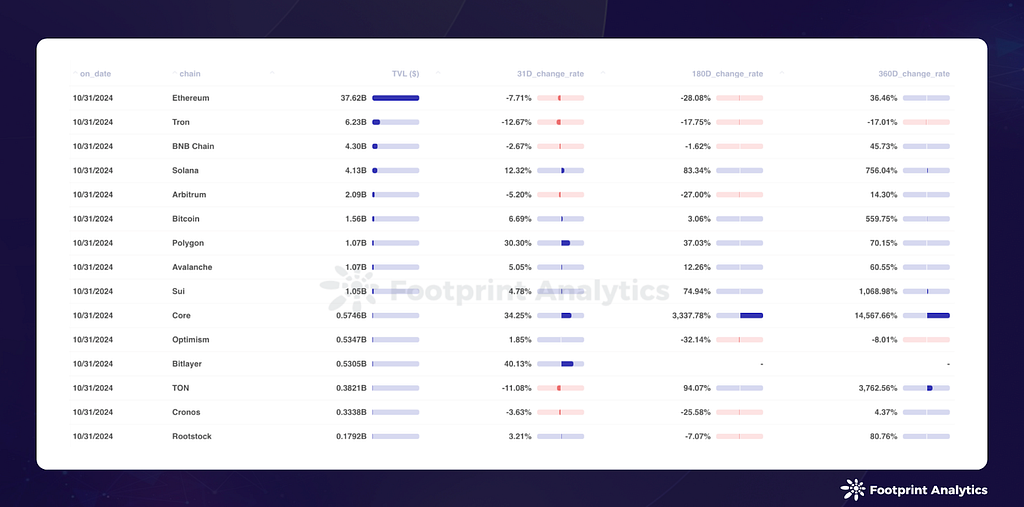
Source: Chain TVL Ranking
Stablecoins continued to demonstrate their crucial role in the crypto ecosystem. Bitwise Research’s Q3 2024 Crypto Market Review revealed that global stablecoin transactions exceeded $5.1 trillion in the first half of 2024, approaching Visa’s $6.5 trillion volume. Tether’s profitability surpassing BlackRock’s highlighted the sector’s financial impact, intensifying competition among chains to secure stablecoin listings on their platforms.
Bitcoin Layer 2 & Sidechain
October 2024 marked another month of robust growth for Bitcoin Layer 2s and sidechains, with total TVL reaching $1.8 billion, a 22.2% increase from September.
Core maintained its sector leadership, growing 29.8% to reach $574.6 million TVL and commanding a 32.4% market share. Bitlayer strengthened its position with a 36.1% increase to $530.5 million TVL, holding 29.9% of the market. Rootstock secured third place with $179.7 million TVL and 10.1% market share, while BSquared emerged as a strong contender, surpassing Merlin Chain to claim fourth position with $170.3 million TVL, representing a remarkable 54.4% monthly increase.

Source: Bitcoin Scaling Solutions TVL
October witnessed significant technological breakthroughs in the Bitcoin Layer 2 ecosystem. BEVM introduced its innovative “Super Bitcoin” framework, presenting a comprehensive approach to expanding Bitcoin’s capabilities while maintaining its fundamental security.
The framework proposes a five-layer architecture with Bitcoin’s network as the foundation, utilizing its proven PoW consensus for security. Building upward, it incorporates Lightning Network technology for efficient communication, Taproot Consensus for standardization, and a multi-chain fusion layer supporting various virtual machines. This architecture culminates in an application layer that enables developers to build DApps while leveraging Bitcoin’s security.
In a significant move bridging Bitcoin and Ethereum ecosystems, BOB network announced its integration with Optimism’s “Superchain.” As a self-described “hybrid layer-2” solution, BOB aims to create seamless connections between Bitcoin and Ethereum, positioning Bitcoin at the center of the DeFi landscape.
Cross-chain functionality saw further advancement with Cardano’s integration with BitcoinOS (BOS). This partnership aims to provide Cardano users direct, trustless access to Bitcoin liquidity.
Besides, BTCFi continued its impressive growth trajectory, highlighted by Babylon’s Bitcoin staking program Cap-2. The program demonstrated remarkable efficiency, attracting 23,000 Bitcoins while incurring minimal fees of just 1.56 BTC. This successful deployment showcases the growing appetite for Bitcoin-based financial products.
Ethereum Layer 2
October 2024 saw modest growth in Ethereum Layer 2 solutions, with total canonically bridged TVL reaching $19.8 billion, a 1.2% increase from September — notably lagging behind the growth rate of Bitcoin scaling solutions. The competitive landscape continued to evolve, with established leaders maintaining dominance while newer entrants gained ground.
Market leaders Arbitrum One and Optimism maintained their positions with 45.3% and 17.8% market share respectively, though both experienced slight decreases. Base emerged as a notable growth story, expanding its market share from 8.1% to 13.4% with a 28.5% TVL increase. This growth was largely attributed to Coinbase’s smart wallet implementation, which streamlined dApp interactions and attracted substantial inflows across lending, derivatives, and DEX protocols. Aerodrome, Base’s native DEX, played a particularly significant role in this expansion.
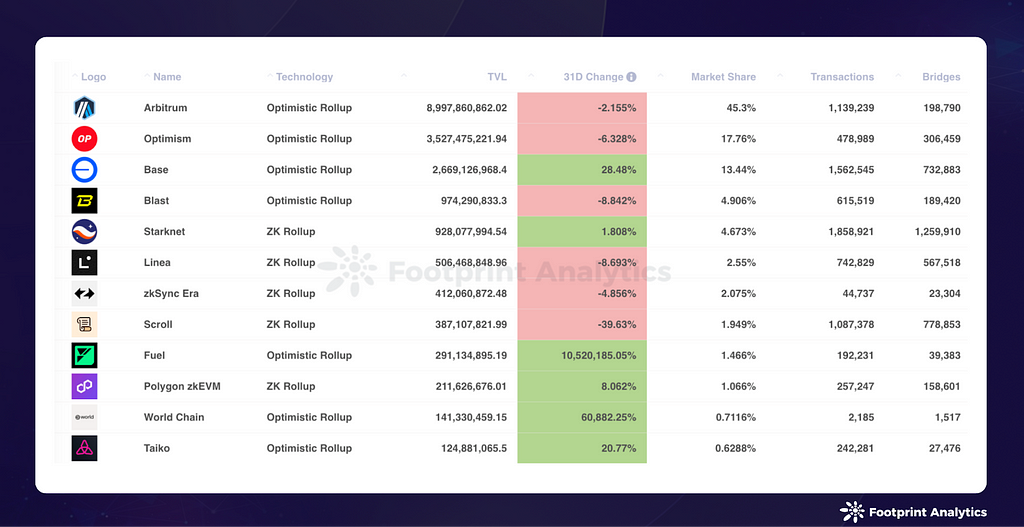
Source: Ethereum Layer 2 Overview- Rollups (Canonically Bridged)
Several new entrants made notable impacts. Fuel Ignition and World Chain saw substantial TVL growth following their mainnet launches, while Taiko’s TVL increased by 20.8%, driven by the success of Panko Finance and Avalon Finance.
However, Scroll’s experience offered a cautionary tale — following its airdrop launch, TVL dropped 39.6%. The airdrop faced community criticism over distribution plans, and like previous cases with zkSync and Starknet, activity declined significantly post-airdrop, with its token price falling over 50% from launch.
Beyond market metrics, October saw increased focus on fundamental ecosystem challenges, particularly regarding user experience and interoperability.
Vitalik Buterin took an active role in addressing community concerns, publishing a series of comprehensive articles examining Ethereum’s future directions. His writings particularly emphasized cross-Layer 2 interoperability as a crucial development priority. The proposed roadmap outlines improvements aimed at unifying the Ethereum ecosystem through standardization of chain-specific addresses, unified payment request systems, and integration of keystore wallets across Layer 2s. These enhancements are designed to streamline cross-chain asset transfers while reducing gas costs for cross-Layer 2 transactions.
Despite ongoing challenges, Ethereum’s Layer 2 ecosystem continued to attract significant projects and developments. October saw several notable mainnet launches. World Network (formerly Worldcoin) went live, bringing its privacy-focused identity solution to mainnet. ApeChain by Yuga Labs launched, leveraging Ethereum’s security for NFT-focused applications, while Eclipse and Fuel Ignition completed their mainnet deployments, adding new scaling solutions to the ecosystem.
A significant development came from Uniswap Labs, which unveiled its plans for Unichain, a new Layer 2 network built on Optimism’s OP Stack. The announcement generated considerable industry discussion, given Uniswap’s dominant position in decentralized exchange protocols. Following the path of major players like Coinbase’s Base and Sony’s Soniem, Unichain’s testnet launch signals a potential shift in Layer 2 competition dynamics, particularly regarding liquidity and gas fee.
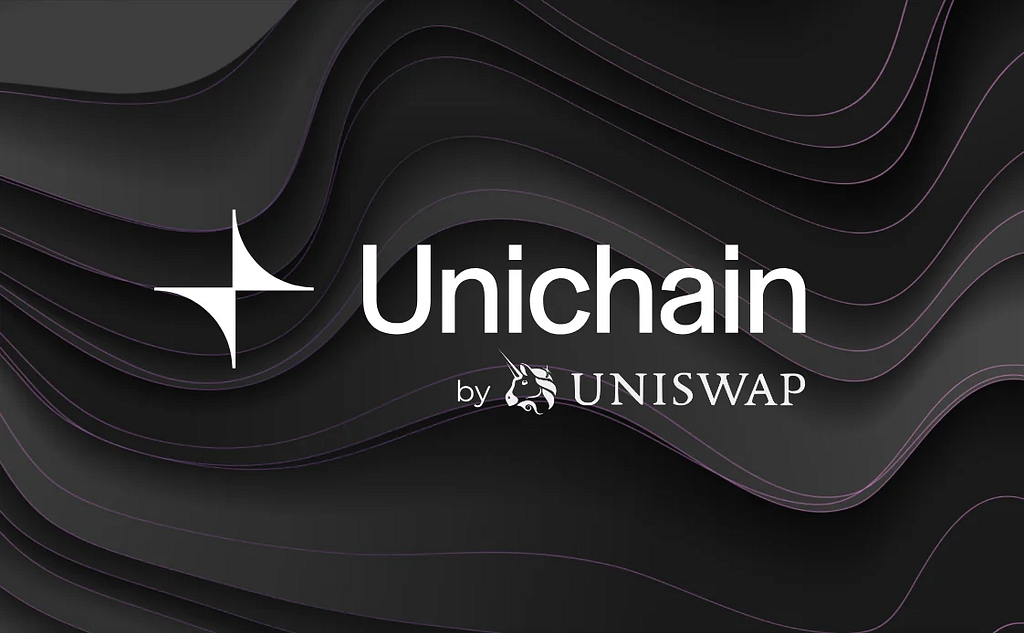
Unichain
For more details on Web3 Gaming, chains funding events, and other chain developments for October 2024, please visit www.footprint.network or click here for more information.
About Footprint Analytics
Footprint Analytics is a comprehensive blockchain data analytics platform that simplifies complex analysis for businesses and projects in the Web3 ecosystem. It offers tailored solutions that eliminate the need for extensive expertise and infrastructure maintenance. The platform provides long-term growth tools designed to help build and manage communities step by step, emphasizing sustainable growth and user loyalty. By combining powerful analytics with community management tools, Footprint Analytics enables projects to leverage blockchain data effectively for decision-making and growth strategies across various sectors including GameFi, NFT, and DeFi.
Website | X(Twitter) | Growthly | Reports | Blog | Telegram | Discord
Disclaimer
The views and opinions expressed in this article are solely those of the authors and do not reflect the views of Bitcoin Insider. Every investment and trading move involves risk - this is especially true for cryptocurrencies given their volatility. We strongly advise our readers to conduct their own research when making a decision.